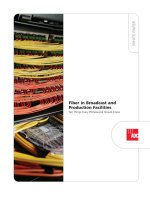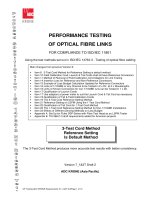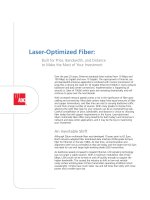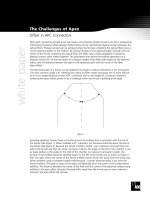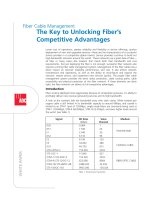Tài liệu ADC KRONE - Guide - How to choose the right Cabling Infrastructure doc
Bạn đang xem bản rút gọn của tài liệu. Xem và tải ngay bản đầy đủ của tài liệu tại đây (666.08 KB, 4 trang )
Building for Bandwidth
How to Choose the Right Cabling Infrastructure
WHITE PAPER
A Brief History of Cabling
Over the past 30 years there have been unprecedented advances in networking
technology. Since the early 1970s with the development of Ethernet, rates for
point-to-point data transfer have increased by a factor of ten thousand. From one
Mb/s StarLan to 10 Gb/s Ethernet, the steady increase in bandwidth has been
fueled by an ever increasing demand for more; more speed, more applications,
more memory and more devices.
Demand for faster speed comes from continual increases in processor capability
and advanced operating systems that enable development of new applications.
These applications and their associated devices create more network usage and
congestion, driving demand for more bandwidth. The need for this additional
bandwidth is seen first at network bottlenecks. When a section of the network
becomes a bottleneck, network equipment, such as Ethernet switches and
servers, are replaced with the next generation of equipment with faster
processors, more memory, improved operating systems and the inherent ability to
run more complex applications.
Over time, network equipment speeds outpace the infrastructure that connects
the devices; In the transition of 10Base-T to 100Base-TX, for example. Networks
with category 3 cabling systems could support the first few generations of
switches and computers that supported 10 Mb/s Ethernet over 100 meters. With
the introduction of the 100Base-TX protocol, bandwidth limitations between
devices were removed. However, category 3 cabling was insufficient to support
the 10x increase in bandwidth, which led to the development of category 5
cabling to support 100 Mb/s over 100 meters.
Ignoring category 4, which came and went quickly, network planners faced
a decision on which cabling system to install. At that time, the majority
of networks operated with 10Base-T network devices. Yet category 3 cabling
would not support the emerging 100Base-TX protocol. The good news, however,
was that category 5 would run 100Base-TX and was backward compatible
with category 3. In other words, any application designed for category 3 (10Base-
T) would run just as well, if not better, on category 5 cabling systems.
The logical choice was to install category 5 in anticipation of applications
requiring 100Base-TX.
Building for
How to Choose the Right Cabling Infrastructure
Bandwidth
Building for Bandwidth
Page 3
Selecting the Infrastructure: Follow
the Lead of IEEE
The same scenario faces network planners today as
cabling systems are designed to withstand multiple
replacements of active equipment. Most active network
equipment– including computers, servers, Ethernet
switches, routers and hubs – have a maximum useful life
of three to five years before they become obsolete. In
contrast, structured cabling historically has a useful life of
10 to 15 years. Therefore, the structured cabling you install
today must outlive at least three generations of
networking equipment upgrades.
The challenge is how to determine what types of active
equipment will exist in three product generations; the
answer can be found with IEEE. This organization consists
of networking, equipment manufacturers such as Cisco,
Nortel, Juniper and others that look at the future of
networking, and develop solutions for future product
generations. Using IEEE standards as a guide, it is possible
to see the direction for both active equipment and cabling
requirements for the next few generations.
IEEE has already
released standards
for 10GbE over fiber
and over shortrange
copper (CX4), and is
rapidly progressing
with IEEE 802.3an,
10GbE over un-
shielded twist pair
copper (UTP), with
ratification expected in June 2006. Other standards bodies
are also active, especially TIA and ISO committees with
their work on Augmented category 6, also known as
category 6a. With the advent of these new standards it is
clear that the IEEE has set a direction that 10GbE over UTP
is going to be a reality in upcoming generations of
network equipment and this is fully supported by the
standards making bodies, TIA and ISO.
Focus on the Critical Decision
Criteria
The questions remain: with all the fiber and copper cabling
choices at your disposal, which do you install today? There
is no simple answer, because each network is unique.
Beware of one-size-fits-all solutions as they cannot
possibly account for the infinite numbers of variables you
must consider when selecting your cabling infrastructure.
As you make your cabling infrastructure decisions, keep
in mind your bandwidth requirements and the timing of
your implementation.
The following are just three possible scenarios based upon
very different network requirements:
Scenario 1: You need 10 GbE right now. If this is the case,
choose 10GbE over fiber. It will be more expensive than
copper, due to media conversion and more expensive ports
on equipment. Yet remember the IEEE 802.3an standard
will not be released until July 2006, and there will be a
delay before the first solutions hit the market following the
release of the standard.
Scenario 2: You are not sure what to do; you occupy space
on a short-term lease, or you are concerned about the
current state of the standards. In this case, the logical
choice is a category 6 cabling solution. You may not be in
the building long and standards for Augmented category 6
are not final. Once the standard is released, it looks like
category 6 will support 10GbE at the shorter distance of 55
meters, just in case you do require 10GbE in the near term.
Why is category 5 not a good choice in this scenario? In
2005, the dominant UTP cabling standard for new
installations shifted from category 5e to category 6. In
addition, category
5e is not recognized
by IEEE or TIA to
support 10Gbase-T
because category 5e
cannot support
10GbE for any
practical distance.
There were early
announcements on
10GbE running on category 5e: yet these tests were only
made on single runs of cable in a laboratory environ-ment,
not on actual installations. In actual installations the noise
generated by adjacent cables (alien crosstalk) is too great
to allow 10GbE transmission for any reasonable distances
over category 5e cabling.
Scenario 3: Building space is on a long term lease or
the building is owned; bandwidth requirements are
substantial. Choose Augmented category 6. History says
your upfront investment will pay off in the long-term.
Augmented category 6 will be more expensive than
category 6, however, the installation time and cost will
be virtually the same. For this scenario, Augmented
category 6 offers a cabling system that will be in
service for at least three generations of active network
gear. In the scope of any networking project, the
infrastructure is a relatively small expense. Adding the
small capital expense for Augmented category 6 cabling
will defer or eliminate future costs of cabling system
upgrades as new applications require replacement of
active networking gear.
IEEE Standards Activity
IEEE 802.3z Gigabit Ethernet over Fiber Released 1998
IEEE 802.3ab 1000Base-T (Gigabit Ethernet over UTP) Released 1999
IEEE 802.3ae 10GbE over Fiber Released 2002
IEEE 802.3ak 10GbE over short range Copper (CX4) Released 2003
IEEE 802.3an 10Gbase-T (10GbE over Copper) July 2006 (Estimate)
ADC Telecommunications, Inc., P.O. Box 1101, Minneapolis, Minnesota USA 55440-1101
Specifications published here are current as of the date of publication of this document. Because we are continuously
improving our products, ADC reserves the right to change specifications without prior notice. At any time, you
may verify product specifications by contacting our headquarters office in Minneapolis. ADC Telecommunications,
Inc. views its patent portfolio as an important corporate asset and vigorously enforces its patents. Products or
features contained herein may be covered by one or more U.S. or foreign patents. An Equal Opportunity Employer
102577AE 05/06 Revision © 2002, 2004, 2006 ADC Telecommunications, Inc. All Rights Reserved
Web Site: www.adc.com
From North America, Call Toll Free: 1-800-366-3891 • Outside of North America: +1-952-938-8080
Fax: +1-952-917-3237 • For a listing of ADC’s global sales office locations, please refer to our web site.
WHITE PAPER
Building For Bandwidth in the Future
Technology advancements in networking will continue.
New processor technology, coupled with new operating
systems, will allow the creation of advanced applications
and services. These new applications will demand more
and more bandwidth, driving the need for higher speed
protocols and cabling to support these protocols. Your
situation may dictate a fiber or a category 6 solution. Yet
if you own your space, or have a long term lease, a good
rule of thumb is to design your passive cabling
infrastructure to endure at least three generations of
active networking gear with an Augmented category 6
solution. To design for three generations, look to the IEEE
and educate yourself on the protocols being developed for
the future. This offers an invaluable guide toward building
for bandwidth in the future.
ADC Infrastructure Solutions
ADC manufactures and distributes a complete portfolio of
standards-based, technologically superior solutions that
support voice, data, security, audio, video, controls and
other building and campus systems. The TrueNet
®
Structured Cabling Solution provides a complete copper
and fiber cable, connectivity and cable management
solution from the entrance facility to the desktop and
across the campus. Supported by an exceptional warranty,
TrueNet is the choice of network manager worldwide who
operate high-value and mission-critical networks.
The chart below shows just a few of the ADC cable
solutions used to support common enterprise applications.
Integral to each solution are the TrueNet patch panels,
fiber frames, connectors, cable management,
termination/splice/storage panels and other products
for every unique requirement in the passive portion of
your network.
Building for Bandwidth
Page 4
IEEE Designation Bandwidth Distance Common ADC TrueNet
®
Solutions
Standard Limitation Applications
802.3ab 1000Base-T 1000 Mb/s 100 meters Desktop Computing • Category 5e and 6
• CopperTen Augmented
Category 6
802.3z 1000Base-SX 1000 Mb/s 220 to 550 meters Enterprise backbone • Laser Optimized
Multimode Fiber
1000Base-LX 1000 Mb/s 5 Kilometers WAN, MAN • Singlemode Fiber
802.3an 10GBase-T 10 Gb/s 100 meters (Cat 6a), Data Center, R&D Computing, • CopperTen Augmented
55 meters (Cat 6) High Resolution Video, Category 6
Advanced Desktop Computing • Category 6
802.3ae 10GBase-SR/SW 10 Gb/s 300 meters Data Center and Enterprise • Laser Optimized
Backbone Cabling Multimode Fiber
10GBase-LR/LW 10 Gb/s 10 Kilometers WAN, MAN • Singlemode Fiber
10GBase-ER/EW 10 Gb/s 40 Kilometers WAN • Singlemode Fiber
10GBase-LX-4 10 Gb/s 300 meters Data Center and Enterprise • Standard Grade
Backbone Cabling Multimode Fiber
10GBase-LX-4 10 Gb/s 10 Kilometers WAN, MAN • Singlemode Fiber
802.3af Power over 10/100/ 100 meters VoIP, WiFi, RFID, IP Security • Midspan PoE
Ethernet 1000 Mb/s



